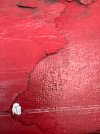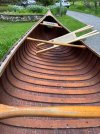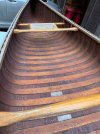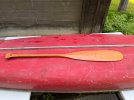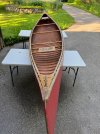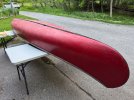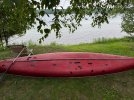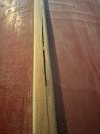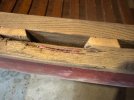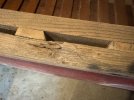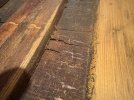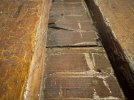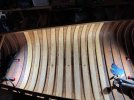seat replacements unless that's a no-no and should be getting the existing ones restrung somehow.
The canoe should be repaired for use and replacing the seats is perfectly acceptable. If I am working on a newer Old Town, I often use replacements seats from Essex Industires rather than make or repair what is there.
https://essexindustries.org/
What kind of resin and glass fibers do you recommend for patching the holes? And the same resin for smoothing over where the glass weave is showing? I do not have experience with two-stage epoxy paints but it seems like I should return the canoe to its original green if possible.
I would not try to get too exotic. My guess is a can of resin and a tube of harder from AutoZone will be perfectly adequate. Or, if you are flush with cash, head to West Marine. They will have all of the available options in stock including the paint.
Sanding the wood inside the canoe and using marine spar varnish to seal it will be a pain with all the nooks and crannies and tough to sand with the grain of the wood.
If you own a wooden canoe, sanding and carpals tunnel are your legacy. You must hand sand every nook and cranny to get the new varnish to grab. I prefer to strip a canoe to bare wood when I canvas it (if it needs it) and then clean/bleach the wood before applying thinned varnish and then many layers of varnish. Tricks? Lots of sanding gadgets out there. I like the little round flapping wheels you can attach to a drill but an orbital palm sander is a go to. I have worn out 4 or 5 of them in the last 20 years. Wooden blocks, foam sanding blocks, corner sanders, you will try them all. DO NOT strip the canoe with the glass on! If you are going to use a wood stripper, remove the fiberglass first. For now, settle for sanding to prep.
In the longer term, do the outside coverings need to be removed down to bare wood, and recanvased?
It depends. From a collectors perspective, 18 foot canoes tend to be less desirable than 16 foot canoes. Old Towns, synonymous with wood and canvas canoes, are also the most commonly available and are even still available new. Your canoe has been glassed and consequently, if you want to restore it, it needs a good deal of work. Your choices are to use it as it is and not sweat the flaws, restore it and in doing so, decide how original and perfect you want it to be, or fix it up enough to use and then buy another one that is in better shape.... for the cost of a restoration, you can buy decent wood and canvas canoes that is ready to paddle. Shop around. You will be amazed at the choices you have. I would lean toward that. I tend to avoid glass removal except on very interesting (to me) canoes.
With your apparent wood-working skills, you have all of the options. and as you have already identified, working with glass and resin is a PITA.
Good luck.



